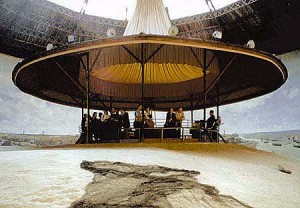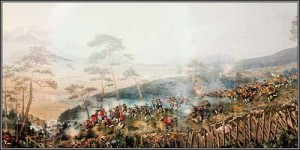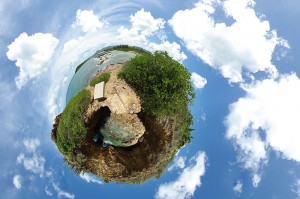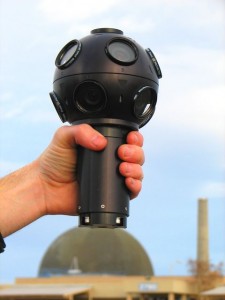“Nothing is more precious than the view of a landscape that is open on every side.”
–Louis-Antoine de Bougainville
 Original panorama’s paintings of the 19th century were a very popular way to represent landscapes and historical events. “The basic aim of a panorama was to reproduce the real world so skillfully that spectators could believe what they were seeing was genuine. Although the techniques of trompe l’oeil painting had been known for centuries, they were never sufficient to create a total illusion of reality. An observer’s gaze could always move beyond the frame, where the actual surroundings contradicted those of paintings, and lighting conditions usually failed to match as well. To achieve a perfect illusion, new techniques of painting were required, but above all a new environment in which paintings could be displayed. The painting had to surround observers and envelop them completely, so as to exclude any glimpse of their whereabouts. An entire pictorial environment was created for visitors to pass through.” [20]
Original panorama’s paintings of the 19th century were a very popular way to represent landscapes and historical events. “The basic aim of a panorama was to reproduce the real world so skillfully that spectators could believe what they were seeing was genuine. Although the techniques of trompe l’oeil painting had been known for centuries, they were never sufficient to create a total illusion of reality. An observer’s gaze could always move beyond the frame, where the actual surroundings contradicted those of paintings, and lighting conditions usually failed to match as well. To achieve a perfect illusion, new techniques of painting were required, but above all a new environment in which paintings could be displayed. The painting had to surround observers and envelop them completely, so as to exclude any glimpse of their whereabouts. An entire pictorial environment was created for visitors to pass through.” [20]
Robert Barker is the person responsible with the creation of the term while describing the panoramic paintings in Endinburgh.
(picture of panorama from innsbruck, austria )
lllllllllllllllllllllllllllllllllllllllllllllllllllllllllllllllllllllllllllllllllllllllllllllllllllllll
lllllllllllllllllllllllllllllllllllllllllllllllllllllllllllllllllllllllllllllllllllllllllllllllllllllll
… became more familiar to the photography audience in panorama pictures
lllllllllllllllllllllllllllllllllllllllllllllllllllllllllllllllllllllllllllllllllllllllllllllllllllllll
New interests and activities from viewers have increased the demands on production and construction of said environments. Such demands include a heightened stress on the communities of hardware development, software development, and budgetary constraints. This investigation pursues a catalog of popular contemporary display technologies in the form of hardware, progressive additions to the field of surface design, and the relevance of the expressed technologies for contemporary panoramas.
llllllllllllllllllllllllllllllllllllllllllllllllllllllllllllllllllllllllllllllllllllllllllllllllllllllllllllllllllllllllllllllllllllllllllllllllllllllllllllllllllllllllllllllllllllllllllllllllllllllllllllll
…currently familiar to the areas of video, artificial intelligence, and gaming
lllllllllllllllllllllllllllllllllllllllllllllllllllllllllllllllllllllllllllllllllllllllllllllllllllllll
lllllllllllllllllllllllllllllllllllllllllllllllllllllllllllllllllllllllllllllllllllllllllllllllllllllll
- ABSTRACT
- ORIGINAL PANORAMA
- TECHNOLOGICAL ADVANCEMENTS
- CATHODE RAY TUBE
- LIQUID CRYSTAL DISPLAYS or LCDs
- PLASMA DISPLAY or PDPs
- DIGITAL PROJECTOR or VIDEO PROJECTOR
- ORGANIC LED DISPLAYS
- PASS-THROUGH DISPLAYS
- CONCLUSION and REFERENCES




